

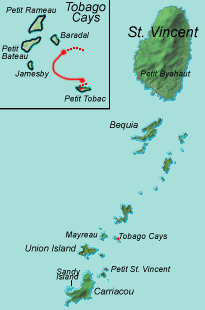
|
We spent the night anchored in the Tobago Cays. Then, in the morning, after breakfast, we went out for a second snorkel. This time, Jeremy took us in the dingy to the outside of Horseshoe Reef (there is a marked channel deep enough for dingies to pass).
Jeremy tied the dingy to a mooring buoy and we all jumped in. We first swam north along the outside of the reef. Jeremy noticed a nurse shark along the reef and pointed him out to me. But the shark swam away before Daphne got a look. We went north as far as was safe (because of the current), and then swam back to the south, and past the dingy.
Even though this was the same reef as yesterday, the snorkeling couldn't have been more different. The outside of the reef is a sloping cliff face, covered with coral. The bottom is quite a distance away, although still visible. Instead of coral heads, as we saw on the leeward side of the reef, the outside is a solid sloping wall of coral. Much of the coral was fire coral, the kind of coral you do not want to touch (1). But that did not stop me from floating above the coral, trying to get a picture of an ellusive moray eel that I noticed slithering around.
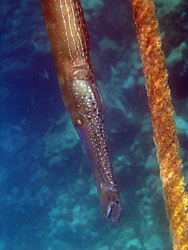 |
Surprisingly enough, I wasted the most pictures on the rope that was being used to moor the dingy. Actually, it wasn't the rope that I was taking pictures off, but rather a trumpetfish that was unsuccessfully trying to hide behind the rope. It was a unique opportunity to get a close picture of this unique fish, since the trumpetfish actually thought that he was successfully hidden or disguised.
After swimming as far south as was safe because of the current, we went back to the dingy. But instead of climbing in, Jeremy let the dingy drift back through the channel in the reef, while we continued to snorkel around the floating dingy. We drifted back to the leeward side of the reef, while Jeremy (dragging the dingy), pointed out various creatures around the coral heads.
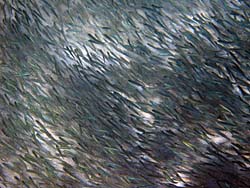 |
After finishing our morning snorkel, Jeremy moved the boat to Petit Tobac, the fifth island in the Tobago Cays, and the only island on the other side of Horseshoe Reef. The line of sight distance was pretty short (say half a mile), but the trip was much longer since we had to go around Horseshoe Reef by motoring southwest, and then back east (2).
We moored the boat just north of Petit Tobac, another area of shallow water over white sand. There was one other sailboat in the area when we arrived, although they left soon after. Then we had lunch (3).
After lunch, we went snorkeling. But first we wanted to go ashore. We swam directly towards the beach, but our path was blocked with reef. So we swam east along the shore looking for a break. We tried a few channels through the shallow reef only to find our way to the beach blocked at every turn. It was laughable. The water was only a few feet deep and we could not have been more than ten feet from shore. But the shallow water reef formations blocked our access. Finally, we found a break in the reef much further to the west, and we climbed out of the water.
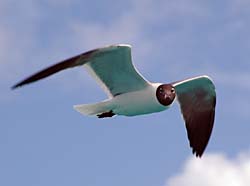 |
After walking around the beach, we climbed back into the water and snorkeled around. We stuck mostly to the shallow water near the shore, which was teaming with schools of six-inch fish. We also saw two sand eels in water a little closer to the boat. While we were snorkeling in close to shore (Daphne really loves the schools of fish), Jeremy went out towards the reef just north of the island. Later, when we returned to the boat, Jeremy mentioned that he saw some lobsters out near the reef.
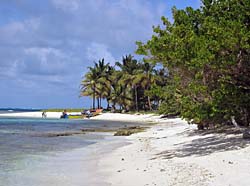 |
The area around Petit Tobac was much less crowded than the center of the Tobago Cays, but it was not as quiet. Those fisherman (or perhaps divers), who were camping on Petit Tobac, ran a compressor (or maybe it was a generator) for a better part of the afternoon, spoiling the otherwise peace and quiet of the area. Oh well, they did eventually stop the noise by evening.
Dinner was chicken curry, and hot sauce. As mentioned before, Jeremy was well stocked with a selection of different hot sauces of varying degrees of spice. The hottest sauce, however, had been opened for a while and Jeremy was concerned that it had lost a little of his bite. Therefore, that bottle got tossed and replaced with an unopened bottle of Jeremy's hottest, which both Jeremy and Joel used (carefully) on their curry.
During dinner, a second sailboat arrived at Petit Tobac, just west of our position. Normally that would not be a problem, but did they have to park such that they blocked the setting sun?
|
Footnote 1: Actually, you do not want to touch any of the coral when you snorkel or dive. Touching the coral damages it and causes the reef to slowly die. Reef damage of this type, both accidental and inadvertent, means that our grandchildren will never have the same ability to see vibrant reefs. That said, touching fire coral results in skin irritation like being stung by a jellyfish.
Footnote 2: Here is a link to a nice map showing the islands and reefs in the Tobago Cays. From this map, you can visualize the route that the Fortitude must have taken to get from a point just southeast of Barbadal to just north of Petit Tobac. You can also see the dingy channel that goes through Horseshoe Reef, due east of Barbadal.
Footnote 3: Although mooring the Fortitude is usually accompanied by an "anchor beer". Daphne did not have any anchor beer this time because she wasn't feeling well. At least that's what she noted in her journal; I do not have any more details (except that it wasn't serious).
![]()
![]()
Introduction |
July 14th (travel day) |
July 15th (Falls of Baleine) |
July 16th (Petit Byahaut) |
July 17th (La Soufriere hike)
July 18th (sail to Bequia) |
July 19th (Union Island) |
July 20th (Sandy Island) |
July 21th (Tobago Cays) |
July 22th (Petit Tobac)
July 23th (arrive at PSV) |
July 24th (West Side Beach) |
July 25th (Atlantic Beach) |
July 26th (Mopion) |
July 27th (travel day)
Photo Galleries
GouldHome | Travel Journals
Text and images © Copyright 2004 Daphne and Joel Gould. All Rights Reserved.
For comments or suggestions about this site contact Daphne Gould.